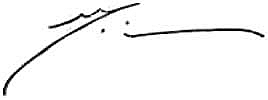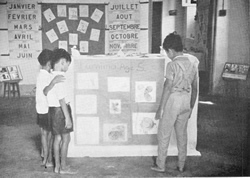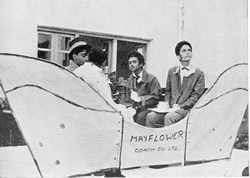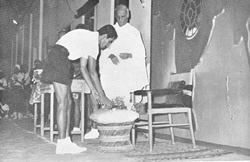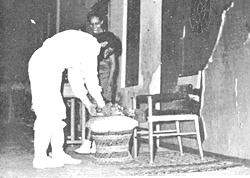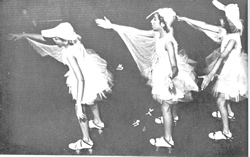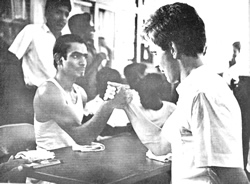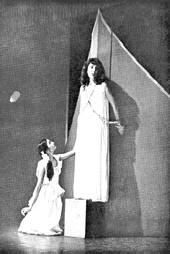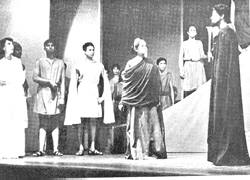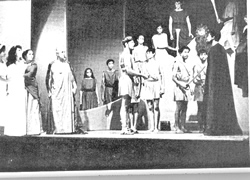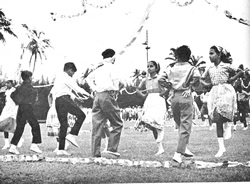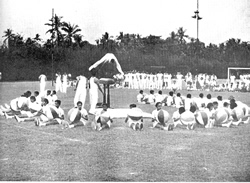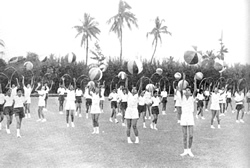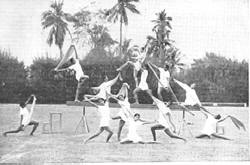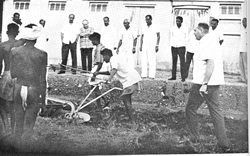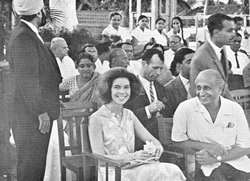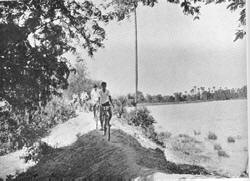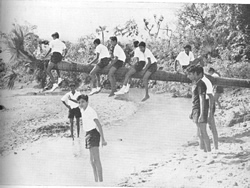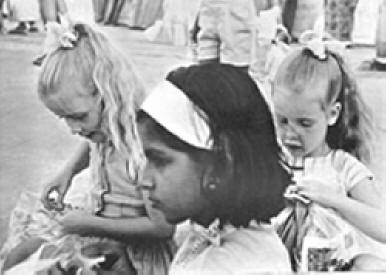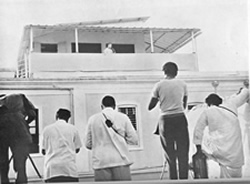|
difficulté. A
un moment où les choses sont très difficiles, quand on a une sorte
d'angoisse, d'inquiétude, que l'on ne sait pas ce qui va arriver,
tout d'un coup, ça jaillit en vous, le mot jaillit en vous. Pour
chacun, ça peut être différent. Mais si on note ça et que, chaque
fois que l'on est en face d'une difficulté, on le répète, c'est
irrésistible. Par exemple, si l'on sent que l'on va être malade, si
l'on sent que l'on fait mal ce que l'on fait, si l'on sent que
quelque chose de mauvais vient attaquer, alors... Mais il faut que
ce soit une spontanéité de l'être, que ça jaillisse de vous sans que
vous ayez besoin de penser : vous choisissez votre mantra parce
qu'il est une expression spontanée de votre aspiration, ce peut être
un mot, deux ou trois mots, une phrase, ça dépend de chacun, mais il
faut que ce soit un son qui éveille en vous une certaine condition.
Alors, quand vous avez ça, je vous réponds que vous pouvez passer à
travers tout sans difficulté. Même en face d'un danger réel,
véritable, d'une attaque, par exemple, de quelqu'un qui veut vous
tuer, si, sans s'agiter, sans se troubler, on répète tranquillement
son mantra, eh bien, on ne peut rien vous faire. Naturellement, il
faut être très maître de soi; il ne faut pas qu'une partie de l'être
soit là à trembler comme une feuille, non, il faut le faire
entièrement, sincèrement, alors c'est tout puissant. Le mieux, c'est
quand le mot vous vient spontanément : vous appelez, n'est-ce pas,
dans un moment de grande difficulté (mentale, vitale, physique,
émotive, n'importe) et tout d'un coup ça jaillit en vous, deux ou
trois mots, comme des mots magiques. Il faut se souvenir de ça et il
faut prendre l'habitude de les répéter au moment où les difficultés
viennent. Si vous en prenez l'habitude, un jour ça vous viendra
spontanément : quand la difficulté viendra, en même temps le mantra
viendra. Alors vous verrez que les résultats sont merveilleux. Mais
il ne faut pas que ce soit une chose artificielle ou que vous
décidiez arbitrairement : "Je me servirai de ces mots-là", ou que
quelqu'un d'autre vous dise : "Oh ! vous savez, ça, c'est très bon"
— c'est peut-être très bon pour lui, mais pas pour tout le monde.
|
one it may be different. But if you
take a note of it and each time
you are face to face with a difficulty, you repeat it, it becomes irresistible.... For example, if you feel that you are about to fall ill, if you feel
what you are doing you are doing badly, if you feel some evil thing is going
to attack you, then... but it must be spontaneous in the being, it must leap
forth from your being without your needing to think of it: you choose
your mantra, because it is the spontaneous expression of your aspiration;
it may be one word or two or three
words, or a sentence, it depends on the
person, but it must be a sound that awakens in you a certain condition.
Then, when you have that, I assure you that you will be able to pass
through all without difficulty. Even in the face of a danger, a real danger,
of an attack, for example from a person who wants to kill you, if, without
getting restless, without getting troubled, you quietly repeat your mantra,
well, none can touch you. Naturally, you must be quite master of your-
self, there should be no part in you trembling like a leaf; you must do it
wholly, sincerely, then it is all powerful. The best is when the word comes
to you spontaneously : you call in a moment of great difficulty (mental,
vital, physical or emotional, it does not matter) and all on a sudden it
springs up in you, two or three words, like magical words; you must re-
member that and you must get the habit of repeating it in moments
when difficulties come. If you form the habit, one day it will come to you
spontaneously; when the difficulty comes, the mantra will come at the
same time. Then you will see that the results are wonderful. But the thing
must never be artificial; you must not decide in an arbitrary way : "I
will make use of these words"; or some other person must not tell you :
"Oh ! you know, this thing is very
good"—it may perhaps be good for
him, but not for everybody.
"Your only object in action shall be to serve,
to receive, to fulfill, to
become a manifesting instrument of the Divine Shakti in her works.”
(The Mother V)
When you act, your only object is to
serve, that is to say, instead of
acting for your personal good, you act to serve, to receive the divine force,
not from outside (you must not believe that it is so) but from within yourself:
|


